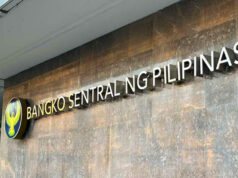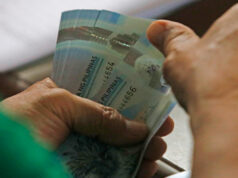Domestic news lifts local financial markets
By Christine Joyce S. Castañeda,
Senior Researcher
LOCAL financial markets performed well for the most part in the third quarter, buoyed by positive news at home amid a slew of uncertainties abroad.
That period saw the peso depreciate against the greenback by 7.44% on a year-on-year basis according to data by the Bangko Sentral ng Pilipinas (BSP), breaching to as low as the P51-per-dollar mark last August – its weakest since a P51.05 finish on Aug. 29, 2006. Traders that time attributed the peso’s depreciation largely to two things: the worsening tensions between the United States and North Korea that have sent investors running for cover away from most Asian currencies and the anticipation of increase in US key rates by the US Federal Reserve.
“Developments in both the external and domestic markets weighed in on the Philippine financial markets in the third quarter. Upbeat global macroeconomic outlook coupled with the reduced expectations of monetary tightening in the US propelled financial markets around the world, including the Philippines,” said BSP Deputy Governor Diwa C. Guinigundo. “On the other hand, heightened geopolitical tensions in mid-August, relating to the US-North Korea dispute and terror attack in Barcelona, Spain, caused some temporary spike in volatilities across financial markets, tempering gains during the quarter.”
The peso’s downtrend was in contrast to the performance of Asian currencies, which appreciated during the three-month period, BSP data showed. Even so, the peso’s volatility was lower compared to currencies such as the Korean Won, Chinese Yuan, Thai Baht, and the Singaporean Dollar among others.
Mr. Guinigundo noted that even with the peso breaching the P51 mark, the local currency was able to rebound slightly to P50.85:$1, or a depreciation of 2.15% year to date by end-September.
Whether or not the Fed would increase key rates yet again this year would largely depend on US economic data, which remain mixed for the most part. Nonfarm payrolls, an indicator closely watched by the Fed in deciding monetary policy, showed a drop by 33,000 jobs in September, posting the first decline in seven years as twin hurricanes that hit the country led to temporary unemployment or delayed hiring, particularly in the leisure and hospitality sector.
However, there were silver linings in that closely watched report. The unemployment rate hit a more than 16-1/2-year low of 4.2% and annual wage growth accelerated to 2.9%, leading analysts to conclude that a rate hike by yearend is still possible.
Likewise affected by external developments were the fixed income markets where BSP’s Guinigundo said “were at their tightest level.”
“The country’s five-year sovereign credit default swap spreads stood at 66 basis points (bps) as of end-September 2017. Long-term sovereign bond yields likewise continued to remain low,” he said.
At the primary bond market, market players preferred short-tenored debt papers. Meanwhile, in the secondary market, yields were lower by 8.71 bps on average with a range of 6.1 bps for the 10-year Treasury bonds to 78.89 bps for the 91-day Treasury bills compared to rates in the second quarter. On the other hand, average yields were up across-the-board by 94.08 bps during the reference period.
A bond trader interviewed by BusinessWorld said that the bond market took its cue from movements in US Treasuries, which in turn, was driven from developments surrounding US President Donald J. Trump’s tax reform plan and his spat with North Korean leader Kim Jong Un as well as the market’s anticipation on the replacement for incumbent Fed Chair Janet L. Yellen, whose four-year term will end in February next year.
The bond trader also noted that the fixed-income market was affected by inflation and supply risk.
SOLID MACROECONOMIC FUNDAMENTALS
The Fed kept interest rates unchanged during its Oct. 31-Nov. 1 meeting. However, policy makers still felt that a rate increase “was likely to be warranted in the near term.”
Despite this, positive developments at home had helped lift investor sentiment, with Mr. Guinigundo citing “solid macroeconomic fundamentals” as shown by manageable credit growth and increased household and government spending.
“At the local front, optimism over the country’s growth prospects contributed to the positive reversals across markets. The likely passage of the government’s tax reform package in Congress along with the rising expectations of positive third-quarter corporate earnings likewise supported the risk-on sentiment among investors.”
The stock market breached the 8,200 levels during the quarter with the Philippine stock exchange index closing to what was then an all-time high of 8,294.14 on Sept. 18, gaining as much as 21% year to date.
Stock valuations remained high during the period, with price-to-earnings ratio being consistently above 20 times, “indicating continued appetite for local shares,” Mr. Guinigundo said.
The quarter also saw the Philippine gross domestic product (GDP) grow by 6.9% — the fastest clip in 12 months though slightly slower than the 7.1% on the back of sustained strong growth in exports and public spending. The reading fueled year-to-date GDP growth to 6.7%, already above the lower end of the government’s 6.5%-7.5% full year for 2017.
The market remained optimistic about the government’s ability to deliver on its promise to spend more than its predecessor. In the last quarter, infrastructure and capital outlays was 15.4% bigger than what was spent in the same period last year. In terms of total expenditures, state spending was 6.97% more albeit slower compared to the 14.44% growth it registered the year prior.
Meanwhile, inflation was kept in check, averaging 3.2% as of October and matching the BSP’s forecast average for the year. Even so, analysts still expect inflation to rise further in the last three months of the year but that the possibility of a local rate hike this year remains highly uncertain.
Asked about the possible global developments that are likely to impact the country’s economic performance in the fourth quarter, analysts cited the anticipated December rate hike accompanied by the new appointment of US Federal Reserve officials and tax reform programs at home and the US.
Analysts also shared their views on the possible effect of the administration’s “Build, Build, Build” program on financial markets.
Ildemarc C. Bautista, vice-president and head of research at Metropolitan Bank & Trust Co., said the program is expected to benefit financial markets.
“We expect that this can push economic growth above 7% on a sustained basis,” he said, adding that the expected amount of imports of capital goods and raw materials amid increased domestic demand may be “potentially inflationary” given a weak peso and would put pressure on interest rates.
However, these higher interest rates, in turn, “will be supportive of the peso and take the edge out of inflationary pressures, keeping inflation expectations well anchored,” Mr. Bautista said.
Meanwhile, the same bond trader interviewed said that the effect would depend on how the program will be funded.
“If TRAIN [Tax Reform for Acceleration and Inclusion Act] kicks in and spending continues as planned, we may see marginal effects on market interest rates,” the bond trader said. “If [instead], TRAIN is watered down or not passed and ‘Build, Build, Build’ continues as scheduled, we may see rates rise with the BTr [Bureau of the Treasury] needing to fund the [country] via issuances.”
For BSP’s Mr. Guinigundo: “Once President Duterte’s “build, build, build” program gains traction, there would be a positive impact on business expectations. Firms would expect a rise in productivity and effective productive capacity, which would translate to higher confidence to invest in more productive activities.”
Below are analysts’ outlooks for each of the key markets:
PESO
Guian Angelo S. Dumalagan, market economist at the Land Bank of the Philippines (Landbank): “The peso is expected to remain weak against the dollar, although it might recover slightly after this year’s plunge. The peso’s recovery may be heavily influenced by the progress on the government’s infrastructure program.”
Ruben Carlo O. Asuncion, chief economist at the Union Bank of the Philippines (UnionBank): “I expect the peso to continue to fall against the US dollar due to the upcoming surge in imports led by the infrastructure push of the Duterte administration. Other factors that would likely contribute to the continuous depreciation of the peso are the US central bank’s continuous interest rate hike and global uncertainties. However, it should be noted that the peso depreciation is not necessarily bad as it promotes the export sector. The impact of the weak peso may be muted at this point with domestic demand continuing to grow.”
Bond Trader: “[FX market will be] pressured higher by offshore players and onshore demand as imports sustain healthy rise.”
STOCKS
Landbank’s Mr. Dumalagan: “Fundamentally speaking, outlook on equities is brighter next year than this year, assuming that the infrastructure program of the government will be rolled out smoothly. However, given that local stocks right now are a bit pricy, we might probably see some downward correction early next year before the index resumes its upward trend.”
UnionBank’s Mr. Asuncion: “Although there are political uncertainties in the Philippines and external political and economic uncertainties, investors are likely to ignore those noise and remain positive on the overall outlook of the stock market. Investors will bank on the implementation of the Tax Reform for Acceleration and Inclusion Act (TRAIN) and will remain optimistic on the Philippine economic growth. Also, the investors are anticipating that the Fed is going to increase rates one more time before 2017 ends.”
Bond Trader: “[The stock market is] down for now but wait for TRAIN to kick in.”
FIXED INCOME
Landbank’s Mr. Dumalagan: “Demand might still be skewed towards short- to medium-dated securities, as investors might still shy away from long-term notes amid rising interest rates.”
Bond Trader: “[The market will be pressured] on rising Treasury yields and local inflation concerns.”



